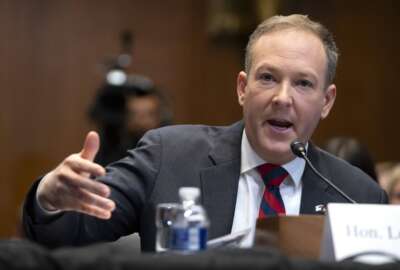Shutdown: It will get worse before it gets better
Think you've seen the worst effects of the government shutdown? Think again, says former DHS CHCO Jeff Neal. As time goes by, more people will be impacted.
Commentary by Jeff Neal
Founder of ChiefHRO.com
& Senior Vice President, ICF International
This column was originally published on Jeff Neal’s blog, ChiefHRO.com, and was republished here with permission from the author.

The government shutdown is everywhere — in the news, in conversations at work, at social events — you name it, people are talking about shutdown. I have been surprised by the number of people who think it is not really a shutdown, or who think what happened Tuesday is what a shutdown looks like. They think it is like a toggle switch — flip it on, and the shutdown happens — flip it off and the shutdown ends. Nice thought, but it just isn’t true.
The shutdown that began Tuesday will get progressively worse as time passes. Its effects will be felt gradually, then expand to harm more and more people, until they become so bad that the US government will become virtually paralyzed. Here’s how that plays out:
There are three categories of employees for shutdown purposes — Exempt, Excepted and Furloughed.
Exempt employees are paid by appropriations that do not have to be passed by Congress every year or by fees or working capital funds. They work during the a lapse of appropriations because their money is still there. They will also continue to get paid for the same reason.
Excepted employees (not the same as the excepted service) work because they are engaged in activities that cannot be allowed to stop. The Border Patrol is a great example. If we took the Border Patrol offline during a shutdown, the number of undocumented border crossings would skyrocket. People who want to do us harm would see an ideal opportunity to get their people into the US. Even though there is no money available to pay them, the work of the Border Patrol is so critical to our safety that they will continue to work. It is important to remember the exception covers their work and not their leave. If an excepted employee wants to take leave, s/he must be furloughed for that time. The legal justification is solid — we can make an exception to protect the border, save a life, engage in diplomacy, or many other excepted functions, but we cannot make an exception to go on vacation. The key point to remember is there is no way to pay excepted employees until the shutdown is over.
Furloughed employees were sent home without pay. There is no money available to pay for their work, and their work does not have the urgency that work such as the Border Patrol has. They are still subject to all of the restrictions and requirements that covered them when they were working. That means they cannot get outside employment without approval, cannot take gifts from contractors or other sources, etc. They are subject to a rapid recall, so they cannot treat the furlough time like a vacation and go away.
Shutdown will get worse before it gets better for a lot of reasons. Here are a few.
Exempt is a moving target. Some exempt employees are paid out of working capital funds that are replenished by fees the agencies charge for their work. A great example is the Defense Logistics Agency (DLA). DLA operates a multi-billion dollar working capital fund that it uses to pay for the operation of the agency. When a shutdown stops or substantially slows buying by their customers, the working capital fund eventually runs out of money. When I was DLA HR Director, we kept 7 – 10 days of cash on hand. Exempt employees whose agencies are funded that way will most likely run out of money if we have an extended shutdown. The number of furloughed employees will increase substantially.
Excepted is a moving target. Some agencies made the decision to send employees home because their work did not have the urgency that would make them exempt. A great example is the Federal Emergency Management Agency (FEMA). We all know how vital FEMA’s service can be, but much like an insurance policy, we don’t need it until we have a problem. Based on the legal requirements for exceptions, many of FEMA’s key staff were furloughed. Now that Tropical Storm Karen is threatening the Southeast, FEMA has to recall those critical people. We should expect to see this type of activity throughout the shutdown. Agencies will release and recall employees as situations change. None of the recalled employees will be paid until the shutdown is over. The uncertainty and disruption to their lives will have an effect on them. Imagine being told to go home, then asked to come back because there is an emergency, then being sent home again as soon as you are finished doing vital and sometimes dangerous work to protect your fellow citizens.
Federal employees are not wealthy people. How long can a furloughed employee go without pay? Financial advisors tell us we should have 6 months of cash in reserve, but many people cannot save enough to do that. What do they do now? And how about the excepted employees who are still working. How long do they continue to work without pay? At some point many of them with the most marketable skills may choose to leave public service and go into the commercial world. The federal government has many highly skilled people whose skills are in demand in the job market. They can and will walk at some point. For those who are furloughed, legislation to provide backpay has passed the House and is likely to be passed by the Senate. Because of the high skills required for many federal jobs, the average pay is about $79,000 per year. We have 800,000 employees furloughed. A one-week shutdown will cost over $1 billion. Even though the backpay promise is great news for federal employees, it does not put money in their bank accounts until the shutdown is over.
There is a big difference in “not urgent” and “not essential. “One of the most wretched terms I’ve heard used is nonessential employee. According to some folks, the people who are furloughed are not essential, so they can be furloughed indefinitely. Many of the so-called nonessential employees run clinical trials at the National Institutes of Health. They process benefit claims and retirement applications. They ensure our environment is clean and safe. They work in intelligence. They handle Small Business Loans. They run NASA programs like the amazing Mars Science Laboratory “Curiosity” Rover. You get the picture. These services may not be urgent for everyone, but for a cancer patient waiting for an experimental drug, a small business in need of an SBA loan, troops whose equipment needs repair, and countless others, these services are vital and the effects of their loss could be devastating. The impact of the shutdown will grow day by day and will eventually become incredibly destructive.
DoD Update. Defense has announced it is bringing most of its employees back as a result of a new interpretation of the “Pay Our Military Act.” DoD guidance provides for pay for those who were Excepted and ends furloughs for employees whose “responsibilities provide support to service members performing active service and their families on an ongoing basis,” or “contribute to sustaining capabilities and force readiness.” The guidance says “There are two distinct categories of civilian employees who fall within the scope of this statutory provision, in addition to those performing excepted activities. The first category includes those employees whose responsibilities provide support to service members performing active service and their families on an ongoing basis. The second category consists of those employees whose responsibilities contribute to sustaining capabilities and Force Readiness and which, if interrupted by the lapse in appropriations, will impact service members’ ability to conduct assigned missions in the future. To fall within this second category, there must be a causal connection between the failure to perform the activity during the duration of an appropriations lapse and a negative impact on military members in the future.” Based on this interpretation of the law, most DoD employees will be back at work on Oct. 7. Given the size of DoD, it is possible that tens of thousands of DoD employees could remain furloughed. Secretary Hagel’s guidance also reiterates the fact that “The Act provides appropriations for personnel; it does not provide appropriations for equipment, supplies, materiel, and all the other things that the Department needs to keep operating efficiently. While the Act permits the Department to bring many of its civilian employees back to work, and to pay them, if the lapse of appropriations continues, many of these workers will cease to be able to do their jobs. Critical parts, or supplies, will run out, and there will be limited authority for the Department to purchase more. If there comes a time that workers are unable to do their work, I will be forced once again to send them home.”
Copyright 2013 by Jeff Neal. All rights reserved.
Jeff Neal is founder of the blog, ChiefHRO.com, and a senior vice president for ICF International, where he leads the Organizational Research, Learning and Performance practice. Before coming to ICF, Neal was the chief human capital officer at the Department of Homeland Security and the chief human resources officer at the Defense Logistics Agency.
Copyright © 2025 Federal News Network. All rights reserved. This website is not intended for users located within the European Economic Area.





